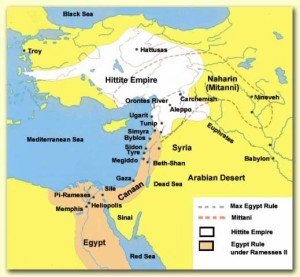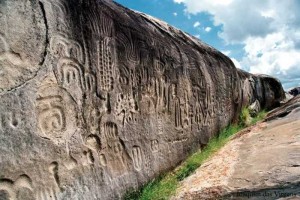Gabriele Baraldi
Homet, Marcel F.
Marcel F. Homet (1897-1982) was a famous French Algerian scientist who published over twenty books  on anthropology, ethnology and ancient history generally. His most famous book is Sons of the Sun[813] in which he discussed his work in South America where he found evidence of Old World connections, in particular, on the famous Pedra Pintada (Painted Rock)(a) in Brazil, in a region that provides evidence of human activity there as early as 40,000 years ago, although, because of the acidic soil the earliest human bones are dated to 12,000 years ago(b). Some of the Pedra Pintada images have been claimed to represent UFOs!
on anthropology, ethnology and ancient history generally. His most famous book is Sons of the Sun[813] in which he discussed his work in South America where he found evidence of Old World connections, in particular, on the famous Pedra Pintada (Painted Rock)(a) in Brazil, in a region that provides evidence of human activity there as early as 40,000 years ago, although, because of the acidic soil the earliest human bones are dated to 12,000 years ago(b). Some of the Pedra Pintada images have been claimed to represent UFOs!
>Just as mysterious is the Brazilian Ingá Stone with its astonlshing collection of carved symbols. One researcher Gabriele Baraldi has interpreted the carvings as evidence of a Hittite presence in Brazil(f).
A 2023 article draws attention to another site in Brazil’s Mato Grosso state known as the Santa Elina rock shelter, where evidence of human activity has been dated to 25,000 years ago(e).<
The title of Homet’s book is his name for Atlanteans. Homet believed that Atlantis had been located in the Atlantic and was part of a landbridge linking Europe and the Americas, an idea that was still popular when he was a child but abandoned long since. Homet contended that refugees fleeing its destruction had escaped to both of those continents. He linked “tools, inscriptions, cults and monuments in both Crete and Egypt on the one hand with the Amazon regions on the other.”
A review of his book is available on the Atlantisforschung website(d).
The final chapter in Homet’s book is devoted to the Phaistos Disk, which he claims to be Atlantean. He continually points out aspects of the ideograms stamped on it that have counterparts in various pre-Columbian cultures. “The totality of the ideograms or symbols on the disc – they are all as familiar in the prehistoric Mediterranean countries as in Ancient America (although of older date there) – leads us inevitably to search for a common origin, which can only be found in the northern part of the space which lies between the two continents (Eurasia and America), in other words: Atlantis!” [p193]
Atlantisforschung lamented the fact that following his death and after a life gathering research material, most was lost or disappeared(c).
(a) Archive 2218
(b) BRASILE PREISTORICO (archive.org)
(c) Marcel F. Homet – Atlantisforschung.de (atlantisforschung-de.translate.goog)
(d) Marcel F. Homet, Atlantis and the Sons of the Sun – Atlantisforschung.de (atlantisforschung-de.translate.goog)
(f) https://brazilweirdnews.blogspot.com/2012/09/the-miystery-of-ingas-stone.html *
Hittites
The Hittites ruled an ancient kingdom, which, at its height controlled most of what is now the Asian part of Turkey. They flourished in the middle of the 2nd millennium BC. Despite the size of the Hittite Empire, there are relatively few surviving examples of Hittite art, so it was interesting to read in September 2021 that the oldest known example of Mediterranean mosaic was unearthed at Usakli Hoyuk, near Yozgat, in central Turkey. It is dated to the 15th century BC, 700 years before the earliest Greek example. “It is the ancestor of the classical period of mosaics that are obviously more sophisticated. This is a sort of a first attempt to do it,” says Anacleto D’Agostino, excavation director(f).
The Hittites were among a number of civilisations in the Eastern Mediterranean and Middle East at the end of the second millennium BC to collapse. In the case of the Hittites Sturt Manning has identified a severe multi-year drought that coincided with the Hittite collapse around 1198-1196 BC. Manning et al in a paper published in Nature in 2023 note that “the Hittite collapse forms part of a wider set of changes occurring across the Old World around 1200 BC. Climate alone was not the sole cause of these changes; very different histories are evident within the greater region”(f).
>In 2023, a reasonably intact inscribed tablet was discovered in the ruins of Büklükale which was formerly a major Hittite city. The 3,300-year-old tablet speaks of the catastrophic invasion of four Hittite cities while the Hittites themselves were in the middle of a civil war. “However, the invasion referenced by the newfound tablet doesn’t seem to be related to the Late Bronze Age collapse. Kimiyoshi Matsumura (its discoverer) said the tablet dates to the reign of the Hittite king Tudhaliya II, between about 1380 to 1370 B.C.- roughly 200 years too early” (h).<
Together with the ancient Egyptians, the Hittites are claimed by ‘rogue archaeologist’ David Hatcher Childress to have been the successors of Atlanteans. He  quotes their appearance, dress and construction techniques to support this contention. However, Childress’ views are very much at odds with the opinion of the professional archaeologist, Eberhard Zangger, who has identified some of the petty states to the west of the Hittite Empire as part of the alliance of Sea Peoples(d) and in that same region, Zangger equates Troy with Atlantis. rather than the enemies to the east.
quotes their appearance, dress and construction techniques to support this contention. However, Childress’ views are very much at odds with the opinion of the professional archaeologist, Eberhard Zangger, who has identified some of the petty states to the west of the Hittite Empire as part of the alliance of Sea Peoples(d) and in that same region, Zangger equates Troy with Atlantis. rather than the enemies to the east.
However, Iurii Mosenkis has published a short paper(e) in which he directly associates the Hittites with Atlantis and the Sea Peoples.
Childress describes them as great seafarers and he attributes to them the exploitation of the vast American copper reserves of North Michigan[620 ch.2].
The idea of Hittites in America is in no way new, as John Campbell (1840-1904) published a paper(b) with that very title in 1881, which is now available online.
The renowned, if controversial, epigrapher, Professor Barry Fell identified the writing on the Newberry Stone, found in 1896 in Michigan, as Hittite-Minoan. As there is no such language as Hittite-Minoan and the ancient exploitation of the Michigan copper mines by Old World traders is unproven(a), Childress’ claims are based on speculation and flimsy circumstantial evidence, which for me are far from convincing.
Even more exotic  was the claim by Gabriele Baraldi that the Hittites had developed an empire in Brazil, offering as evidence the petroglyphs on the Ingá Rock(c). Baraldi also located Atlantis in northeast Brazil.
was the claim by Gabriele Baraldi that the Hittites had developed an empire in Brazil, offering as evidence the petroglyphs on the Ingá Rock(c). Baraldi also located Atlantis in northeast Brazil.
(a) See Archive 2547
(b) https://openlibrary.org/books/OL24141925M/Hittites_in_America
(c) https://brazilweirdnews.blogspot.ie/2012/09/the-miystery-of-ingas-stone.html
(d) https://luwianstudies.org./
(e) https://www.academia.edu/38743064/The_Hittite_Empire_in_the_myth_of_the_Atlantis
